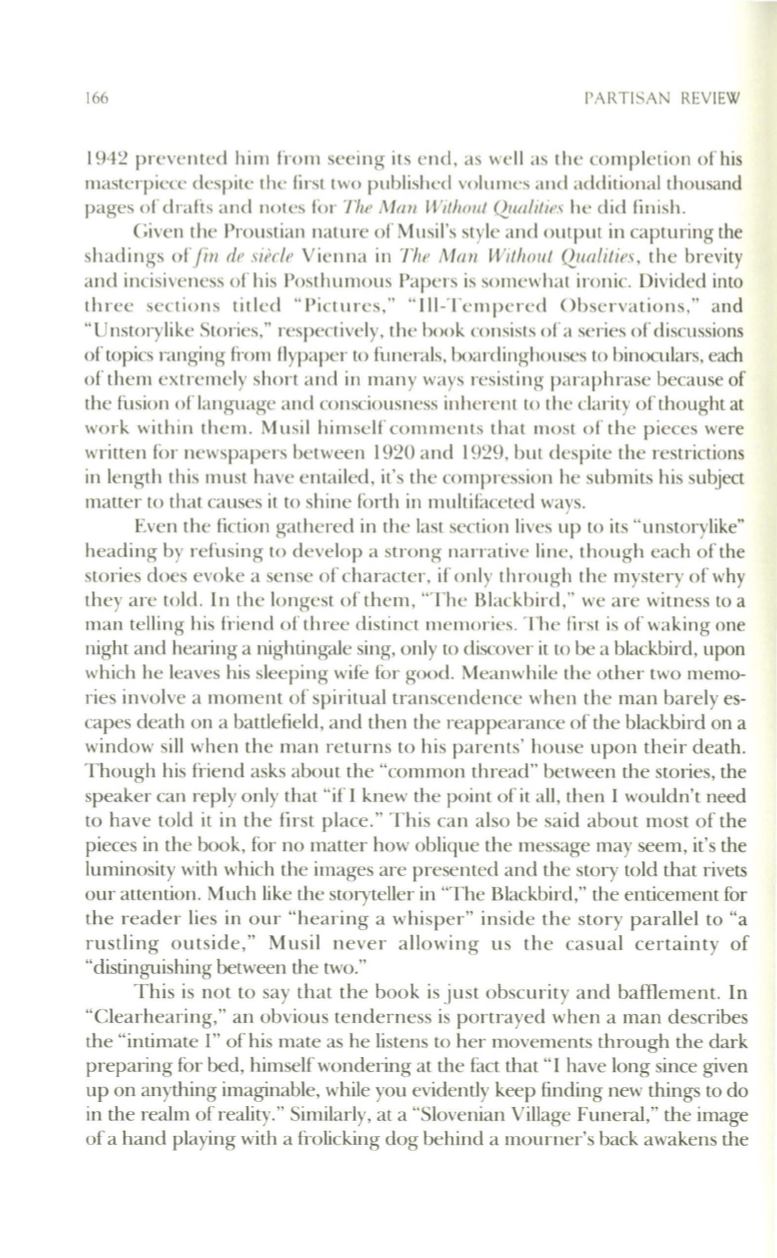
166
PARTISAN REVIEW
1942 prevented him from seeing its end, as well as the completion of his
masterpiece despite the first two published volumes and additional thousand
pages of drafts and notes f{)r
The Man
WilllOul Qualilies
he did finish.
Given the Proustian nature of Musil's style and output in capturing the
shadings
ofJill de sieelp
Vienna in
Thl' Mon Witholll Qllalilips,
the brevity
and incisiveness of his Posthumous Papers is somewhat ironic. Divided into
three sections titled "Pictu res," "III-Tempered Observations," and
"Unstorylike Stories," respectively, the book consists of a series of discussions
of topics ranging from flypaper to funerals, boardinghouses to binoculars, each
of them extremely short and in many ways resisting paraphrase because of
the fusion of language and consciousness inherent
to
the clarity of thought at
work within them. Musil himself comments that most of the pieces were
written f()r newspapers between 1920 and 1929, but despite the restrictions
in length this must have entailed, it's the compression he submits his subject
matter
to
that causes it to shine forth in multifaceted ways.
Even the fiction gathered in the last section lives up to its "unstorylike"
heading by refusing to develop a strong narrative line, though each of the
stories does evoke a sense of character, if only through the mystery of why
they are told. In the longest of them, "The Blackbird," we are witness
to
a
man telling his friend of thl'ee distinct memories. The fil'st is of waking one
night and hearing a nightingale sing, only to discover it
to
be a blackbird, upon
which he leaves his sleeping wife for good. Meanwhile the other two memo–
ries involve a moment of spiritual transcendence when the man barely es–
capes death on a battlefield, and then the reappearance of the blackbird on a
window sill when the man returns to his parents' house upon their death.
Though his friend asks about the "common thread" between the stories, the
speaker can reply only that "if I knew the point of it all, then I wouldn't need
to have told it in the first place." This can also be said about most of the
pieces in the book, for no matter how oblique the message may seem, it's the
luminosity with which the images are presented and the story told that rivets
our attention. Much like the storyteller in ''The Blackbird," the enticement for
the reader lies in our "hearing a whisper" inside the story parallel to "a
rustling outside," Musil never allowing us the casual certainty of
"distinguishing between the two."
This is not to say that the book is just obscurity and bamement. In
"Clearhearing," an obvious tenderness is portrayed when a man describes
the "intimate I" of his mate as he listens to her movements through the dark
preparing for bed, himself wondering at the fact that" I have long since given
up on anything imaginable, while you evidently keep finding new things
to
do
in the realm of reality." Similarly, at a "Slovenian Village Funeral," the image
of a hand playing with a frolicking dog behind a mourner's back awakens the


